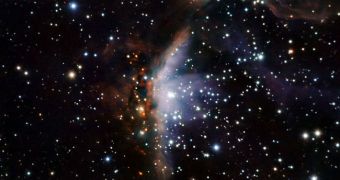Today, March 31, astronomers at the European Southern Observatory (ESO) release a new and highly-detailed map of a little-known region of space called Gum 19. This particular structure is basically a nebula, but it has a catch. When viewed in the infrared portion of the electromagnetic spectrum, it reveals two very different halves. One of them is shrouded in darkness, whereas the other half is bright. The difference is caused by the fact that the supergiant blue star called V391 Velorum is emitting considerable amounts of radiation that cast light on half of its parent nebula.
Consisting mostly of hydrogen gas, Gum 19 is highly susceptible to this type of influences. As solar winds from V391 sweep the area, they heat up the hydrogen, which then begins to glow strongly in infrared wavelengths. The left side of the nebula, as seen in this image, is the one that produces most new stars, as conditions here are ripe for stellar formation. The conditions in the clouds of cosmic gas and dust are appropriate for massive accumulations of mass, which then become too heavy and collide under their own weight, igniting themselves in the process.
It is currently estimated that, eons from now, Velorum will go out in a massive supernova explosion. Adding to this event, the massive number of new blue stars that will be produced by that time will change the appearance of Gum 19 significantly. The nebula will most likely lose its current aspect, and the temperatures present inside its two halves will most likely balance each other out. The entire structure is located no less than 22,000 light-years away from our planet, in the direction of the constellation Vela, also known as “the Sail.”
This recent image of Gum 19 was captured by ESO astronomers using the SOFI infrared instrument, which is mounted on the New Technology Telescope (NTT). The facility is a part of the La Silla Observatory, which ESO operates high in the Chilean Andes. Experts have to use infrared wavelengths for their studies because this is the only way to pierce the thick layer of dust that surrounds the areas of interest inside the nebula.

 14 DAY TRIAL //
14 DAY TRIAL //